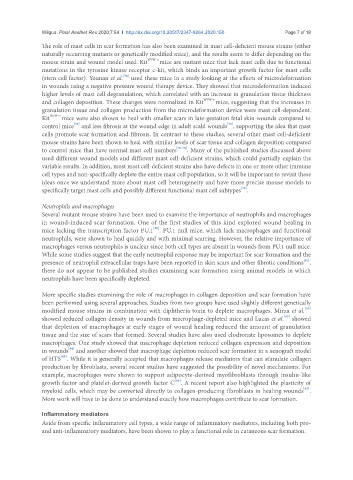Page 628 - Read Online
P. 628
Wilgus. Plast Aesthet Res 2020;7:54 I http://dx.doi.org/10.20517/2347-9264.2020.150 Page 7 of 18
The role of mast cells in scar formation has also been examined in mast cell-deficient mouse strains (either
naturally occurring mutants or genetically modified mice), and the results seem to differ depending on the
mouse strain and wound model used. Kit W/W-v mice are mutant mice that lack mast cells due to functional
mutations in the tyrosine kinase receptor c-kit, which binds an important growth factor for mast cells
[74]
(stem cell factor). Younan et al. used these mice in a study looking at the effects of microdeformation
in wounds using a negative pressure wound therapy device. They showed that microdeformation induced
higher levels of mast cell degranulation, which correlated with an increase in granulation tissue thickness
and collagen deposition. These changes were normalized in Kit W/W-v mice, suggesting that the increases in
granulation tissue and collagen production from the microdeformation device were mast cell-dependent.
Kit W/W-v mice were also shown to heal with smaller scars in late-gestation fetal skin wounds compared to
[75]
[53]
control mice and less fibrosis at the wound edge in adult scald wounds , supporting the idea that mast
cells promote scar formation and fibrosis. In contrast to these studies, several other mast cell-deficient
mouse strains have been shown to heal with similar levels of scar tissue and collagen deposition compared
to control mice that have normal mast cell numbers [76-78] . Many of the published studies discussed above
used different wound models and different mast cell-deficient strains, which could partially explain the
variable results. In addition, most mast cell-deficient strains also have defects in one or more other immune
cell types and non-specifically deplete the entire mast cell population, so it will be important to revisit these
ideas once we understand more about mast cell heterogeneity and have more precise mouse models to
[79]
specifically target mast cells and possibly different functional mast cell subtypes .
Neutrophils and macrophages
Several mutant mouse strains have been used to examine the importance of neutrophils and macrophages
in wound-induced scar formation. One of the first studies of this kind explored wound healing in
mice lacking the transcription factor PU.1 . PU.1 null mice, which lack macrophages and functional
[80]
neutrophils, were shown to heal quickly and with minimal scarring. However, the relative importance of
macrophages versus neutrophils is unclear since both cell types are absent in wounds from PU.1 null mice.
While some studies suggest that the early neutrophil response may be important for scar formation and the
presence of neutrophil extracellular traps have been reported in skin scars and other fibrotic conditions ,
[81]
there do not appear to be published studies examining scar formation using animal models in which
neutrophils have been specifically depleted.
More specific studies examining the role of macrophages in collagen deposition and scar formation have
been performed using several approaches. Studies from two groups have used slightly different genetically
[82]
modified mouse strains in combination with diphtheria toxin to deplete macrophages. Mirza et al.
[83]
showed reduced collagen density in wounds from macrophage-depleted mice and Lucas et al. showed
that depletion of macrophages at early stages of wound healing reduced the amount of granulation
tissue and the size of scars that formed. Several studies have also used clodronate liposomes to deplete
macrophages. One study showed that macrophage depletion reduced collagen expression and deposition
[84]
in wounds and another showed that macrophage depletion reduced scar formation in a xenograft model
of HTS . While it is generally accepted that macrophages release mediators that can stimulate collagen
[85]
production by fibroblasts, several recent studies have suggested the possibility of novel mechanisms. For
example, macrophages were shown to support adipocyte-derived myofibroblasts through insulin-like
[86]
growth factor and platelet-derived growth factor C . A recent report also highlighted the plasticity of
[87]
myeloid cells, which may be converted directly to collagen-producing fibroblasts in healing wounds .
More work will have to be done to understand exactly how macrophages contribute to scar formation.
Inflammatory mediators
Aside from specific inflammatory cell types, a wide range of inflammatory mediators, including both pro-
and anti-inflammatory mediators, have been shown to play a functional role in cutaneous scar formation.

